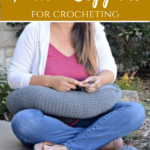Pillow Support Crochet Pattern & Stretches for Crochet Fatigue
This post may contain affiliate links, meaning that I may earn a small commission if you make a purchase. See our disclosure policy for more information.
While crocheting, especially in the crochet crunch time leading up to the holidays, your body may begin to experience crochet fatigue. What in the world is crochet fatigue, you ask? If you experience a sore neck, sore shoulders, sore elbow, or sore hands after a crochet binge then you, my friend, are experiencing crochet fatigue. Which means you need a pillow support for crochet!

This pillow gives our elbows something on which to rest which, in turn, brings the work closer to the face. This means that we are not hunched over trying to see our stitches. Did you know that for every inch your head hangs forward (while crocheting/knitting/playing on your cellphone/reading etc) an additional eight to ten pounds of pressure is placed upon your upper back and shoulders? For each and every inch! Talk about straining those muscles, which then begin to weaken, which leads to dull aches and headaches, which leads to less crochet time, which leads to sadness and despair. For me, at least. 😉


Stretches for Crochet Fatigue
Before we get to the free crochet pattern for the pillow support, let’s go over the WHY you get crochet fatigue and some basic stretches that will help you crochet longer and more comfortably. If you watch the weekly LIVE videos on the Heart Hook Home Facebook page, you’ll know that my sister, Dr. Meadow, is a professor of anatomy at a prestigious chiropractic college. She is also a knitter, crocheter, and general crafter. A BIG thank you to her for explaining what muscles/nerves we are straining as we work and how to strengthen said muscles (even if we can’t pronounce them). Ha!
The deep neck and upper back muscles that take the brunt of the abuse of crochet fatigue include: trapezius, rhomboid major and minor, levator scapulae, splenius capitus and cervicis, semispinalis cervicis and capitis, erector spinae group cervical and capitus portions (longissimus and spinalis in particular).
It’s okay if you didn’t read all of that. 😉
Many of the forearm and wrist movers (flexors, extensors, and rotators) originate just above the elbow. The fast and repetitive twisting motion of crochet means that these muscles can become inflamed. Stretching these muscles and varying their movements can get the blood flowing and relieve tension on compressed nerves.
The continued and prolonged forward head translation (hanging your head to see your stitches or to play with your cellphone etc) can cause problems on the front side of our bodies, too. Compression of the nerves and vasculature to the arms leads to tingling, a dull ache, pain, and loss of strength in the arms (usually on both sides in this case). Also, since the muscles on the lower front of the neck help to increase the size of the rib cage when we breathe (especially deeply), it means reduced volume of breath and less oxygen to your tissues.
Finally, all this repetitive and compressive strain of crocheting, sitting too long in one position, etc, can remodel the bones over time so that they become unable to realign properly. That puts pressure on neurovasculature (arteries, veins, nerves) leading to pain, numbness, tingling, bad skin tone and texture, loss of strength, etc etc.
Thanks, Meadow! Now let’s discuss what we can do about it, mmmkay?
Some stretches that will alleviate crochet fatigue:
Wall Angels will help to strengthen the upper back and shoulder region. For this exercise you will stand as straight as possible with your back against the wall; shoulder blades touching the wall at all times. Bend your elbows and raise and lower your arms as you would to make a snow angel in the winter. This strengthens the muscles which support your neck and head.
Forearm stretches will help to alleviate the crochet fatigue in your arms and elbows. Place your hands flat on the wall and stretch those muscles out.
Take a break! I know, I know. TRUST ME, I know. You get in a crochet groove, your behind is molded your chair, and you’re knocking out that project. If, however, every time you get up to get a drink, to use the restroom, or to tend to the kids or pets, take a few minutes to stretch those muscles out and you’ll be able to crochet longer and more comfortably!

Wanna save this for later?

Pillow Support Crochet Pattern
Materials:
Approx. 350 yards bulky (size 5) yarn
Crochet hook in size J/6mm
Polyfil (about 12 – 15 oz)
Pantyhose (optional, but it helps to keep stuffing from working its way out of the stitches! More on that here.)
Gauge: 10 sts x 6 rounds = 4″ square

Pattern Notes:
The chain at the beginning of the round does not count as a stitch.
The first stitch of each round is made in the same stitch as join.
I used the yarn under method of starting each row to help keep the seam from migrating.
The few slip stitches across the curved portions also help keep the pillow from twisting.
If you need help reading a crochet pattern, make sure you head over here and check out this detailed post.

Get the ad-free, printable PDF of this pattern here.
Pin it for later here.
Round 1: Magic circle, ch-2, 10dc in circle. Join to top of first dc with sl st. (10)
Round 2: Ch-2, 2dc in each st around. Join to top of first dc with sl st. (20)
Round 3: Ch-2, * dc in next, 2dc in next * repeat between * * around. Join to top of first dc with sl st. (30)
Round 4: Ch-2, * dc in next 2 sts, 2dc in next * repeat between * * around. Join to top of first dc with sl st. (40)
Rounds 5 – 13: Ch-2, dc in each st around. Join to top of first dc with sl st. (40)
Round 14: Sl st in first (this helps to keep the pillow from curling) Ch-1, hdc in same and next 17 sts. Dc in next 22 sts, Join to first hdc with sl st. (40)
Round 15: Ch-1, hdc in same st, sc in next 16 sts, hdc in next. Dc in next 22 sts. Join to first st with sl st (40)
Round 16: Ch-1, hdc in same st, sl st in next 16 sts, hdc in next. Dc in next 22 sts. Join to first st with sl st (40)
Repeat rounds 15 & 16: FIVE times
**start stuffing**
Rounds 27- 31: Repeat round 15
Round 32: Sl st in first (this helps to keep the pillow from curling) Ch-1, hdc in same and next 17 sts. Dc in next 22 sts, Join to first hdc with sl st. (40)
Rounds 33 – 37: Ch-2, dc in each st around. Join to top of first dc with sl st. (40)
***if you’d like added width, simply continue until desired width reached***
Round 38: Sl st in first (this helps to keep the pillow from curling) Ch-1, hdc in same and next 17 sts. Dc in next 22 sts, Join to first hdc with sl st. (40)
Rounds 39 – 42: Repeat round 15
Round 43: repeat round 16
Round 44: repeat round 15
Repeat rounds 16 & 15: FIVE times
**add more stuffing**
Round 55: repeat round 14
Rounds 56 – 64: Ch-2, dc in each st around. Join to top of first dc with sl st. (40)
**add more stuffing**
Round 65: Ch-2, * dc in next 2 sts, dc2tog * repeat between * * around. Join to top of first dc with sl st. (30)
Round 66: Ch-2, * dc in next, dc2tog * repeat between * * around. Join to top of first dc with sl st. (20)
Round 67: Ch-2, dc2tog around. Join to top of first dc with sl st. (10)
Finish stuffing and fasten off leaving a long tail for sewing end shut.
You. Are. Done! This support pillow will help eliminate crochet fatigue, but also remember to take breaks and to work your stretches. Crochet on, friends!
more Free crochet patterns and tutorials:
Straight Up EASY Vertical Stripes Sweater Free Crochet Pattern
Easy Peasy Lemon Squeezy Pullover Crochet Pattern
How to Size Crochet Beanies + Master Beanie Pattern
Four-Hour Fall Sweater Free Crochet Pattern
Which Cotton? A Cotton Yarn Comparison for Crafters
How to Make an Invisible Join in Crochet
Caron Big Cake Carry-All Bag One Skein Wonder
How to Sew Crochet Pieces Together Using the Mattress Stitch








